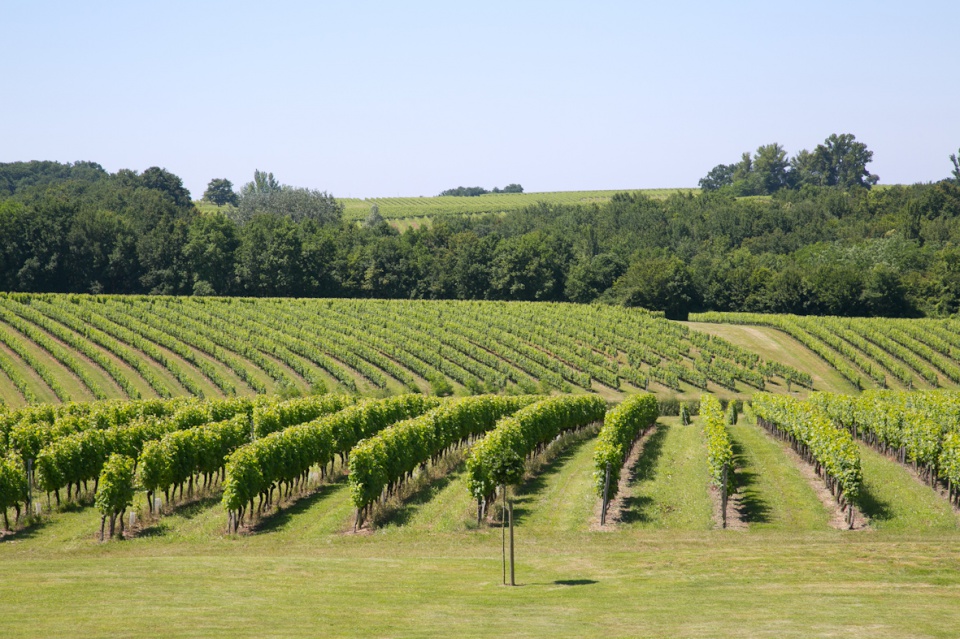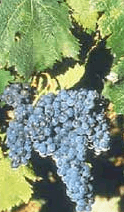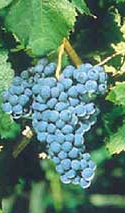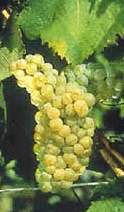From vine to wine
Geographical location
The AOC Entre Deux Mers is located between the Garonne to the South and the Dordogne to the North – two rivers with oceanic influences. Over time, these two rivers have deposited layers of sand, gravel and clay. These layers intermingled with the older chalky rocks, resulting in the terroirs being highly diverse. The vineyard is located on high ground cut through by numerous watercourses that have been formed from the hillsides.
The grape varieties
The Chateau Queyret-Pouillac has 50 Ha of vines that comprise the traditional types of grape in the Bordeaux region that go into the composition of the wines. It is this blend that gives the wines from this estate their complexity and equilibrium.
43 Ha of red grape varieties
- 60% Merlot
- 20% Cabernet Sauvignon
- 20% Cabernet Franc
Grapes from the red grape vines are picked on different days depending on their maturity. After the destemming and pressing stage the harvest is placed into stainless steel vats, and the pumping over and yeast pitching is carried out. The alcoholic fermentation is managed at between 24 and 28° as well as during the vat fermentation period. Once the desired structure has been achieved, then the wines are poured out. The malolactic fermentation around 21° then takes place, which relaxes the wines. A part of the wines will be matured in barrels for a year to produce our Special Reserve and the other part will be aged for 12 to 18 months in a vat prior to being bottled.
Merlot
Merlot is the most widespread grape in the Bordeaux region, and presents with a maturity that is quite early. The grape brings to the wine a suppleness together with roundness, colour, a red fruit aroma and the heat of its alcohol. Merlot has the advantage of bringing suppleness to the blend thanks to its velvety tannins, making it a wine that can be drunk more quickly.
Cabernet Sauvignon
Cabernet Sauvignon is the region’s traditional grape variety and presents with a more delayed maturity than the Merlot. It brings structure to the wine together with vigorous tannins and an aromatic profile of black fruit. Its tannic structure means that the wines have the opportunity to age, giving them time to loosen up.
Wine production technique
The choice of the most suitable root-stock for a high quality clone is made based on soil analyses taken right at the outset. All work carried out on the vine is done with the aim of getting the best quality grape – a crucial condition of ending up with a great wine. These are the essential requirements:
- The minimum amount of fertiliser is used to restrict the yield and to bring balance to the vine.
- The Guyot double pruning method is practised, with just 3 to 4 buds per cane, to restrict the yield and achieve better grape distribution.
- Removal of bud heads and leaf removal at grape level to improve the phytosanitary state and the maturity of the harvest to come.
- If necessary, removal of bunches of grapes for optimum yield and to achieve phytosanitary conditions favourable to better maturity.
- Phytosanitary treatments are planned with a view to respecting the environment.
- Analysis of maturity in order to get the harvest started on the optimum day.
7 Ha of white grape varieties
- 50 % Sauvignon
- 50 % Sémillon
After being taken through the destemming and pressing stage which, among other things, allows the grapes to burst the grapes of white and rosé wines are taken straight to a pneumatic press. The juice that is recovered is cold-treated in order to trigger the release of the suspension deposit, and it is then separated from this deposit with the light juice being yeasted at around 14° and subsequently heat-regulated at around 18° in order to achieve a long alcoholic fermentation, thereby preserving the aromas. After the alcoholic fermentation stage, the wines are stirred up (returning to their suspension in the fine lees) 2 to 3 times a week to give them aroma and complexity. Once the wine has been aged then the white and rosé wines are blended and prepared for bottling.
Sauvignon
The Sauvignon is a more vigorous grape variety for carefully managed yields, and is therefore a high quality vine. It brings to the wine a vivacity together with an acidity that is required to balance it out, as well as powerful aromas. The varietal aroma of the Sauvignon is highly characteristic, with notes of citrus fruits – especially grapefruit and lemon.







